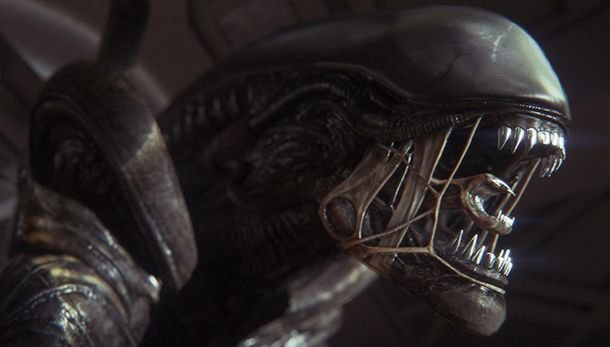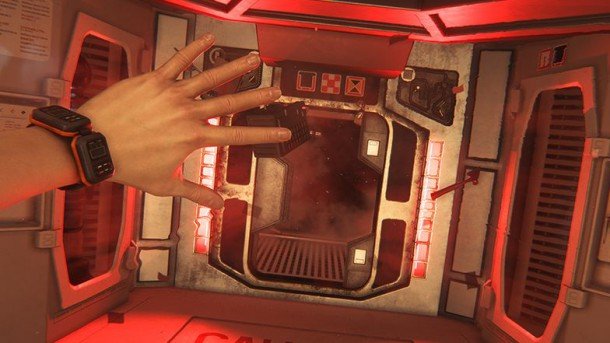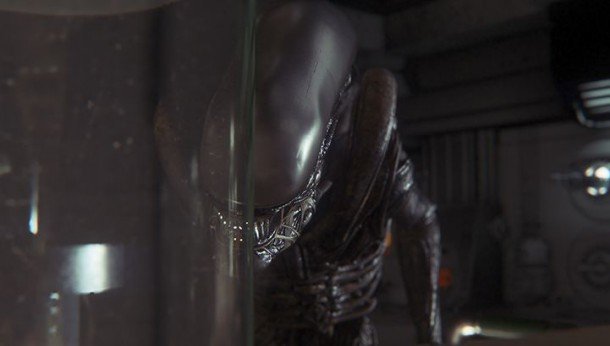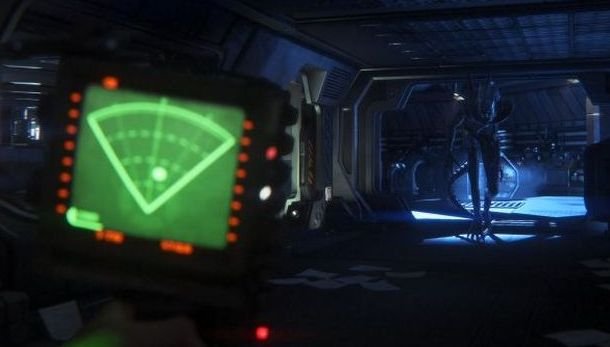
I started to understand Alien Isolation the moment I had to sprint to reach a hiding place at the serious risk of attracting the alien's attention. Up until then, I'd assumed stealth was the only way to play Creative Assembly's survival horror title, but the method with which you survive varies depending on the odds of the situation. Sometimes stealth yields the most rewarding journey through a level – but sometimes being brave and bombing it to safety might just keep you alive.
In case you're unfamiliar with what Creative Assembly is up to, here, Alien Isolation is the tonal opposite of Colonial Marines, putting much of its stock in the idea of contending with a single alien life form in a world crafted entirely around the context of the 1979 movie – the rest of the lore be damned. What I learned in this one scenario is that the alien CA have created is both reactive and random, and that no methodology can ever be a sure bet for circumventing the monster's behaviour.
In the level Tom and I sampled (the same as Chris took a look at for our cover on the game), there's a bit of build-up and exploration that doesn't involve the alien at all. The scenario where the alien stalks the corridors of the Sevastopol forms the second half of the level, and demonstrates how much can happen as a result of the creature's dynamic AI. The environment where I meet the alien is a circular corridor with one connecting office room in the middle. The alien loves to use that central room to move rapidly from one part of the corridor to the other, meaning that I have to be vigilant of that route in case it tries to catch me out (hint: it does, six times, before I beat the demo).
My tactic is staying out of the alien's way, no matter what. I don't get brave or hide behind pillars hoping to catch a glimpse of the towering predator, I try and figure out what the creature's line of sight is and I cower accordingly. Brushing with danger holds little appeal for me; the game sets up the alien in a scripted sequence by having the beast run its tail near your character, Amanda Ripley. There are two sets of lockers surrounding the central rooms that I alternate between, depending on the alien's position Hiding under desks just doesn't feel as safe as having that door between you and the seething menace.
The crux of my Alien Isolation experience is making out what the creature's sounds represent – a frustrated scream can mean it's either about to charge and slaughter me, or it could signal that it's sensed something but can't figure out my exact location. A lot of my time is spent leaning back in lockers and holding Ripley's breath while the alien sniffs the air and storms past. This is probably the scariest part of Alien Isolation, existing in such close proximity to this foe but not being entirely aware of whether it knows you're there or not. I die a locker-related death twice, both times for failing to escape the alien's line of sight.

I keep the motion tracker up at all times. For some reason I always get the urge to run when the motion tracker shows it getting too close and I'm not hidden in a locker, leading to my horrible but somewhat fancy demise through the game's pretty death animations as Amanda is pulled screaming into the darkness.
During this scenario, players are required to backtrack to the start of the level where the airlock breaks, before having to return through the alien-occupied corridor. This is where running had its advantages – the broken airlock triggers some loud noises that the creature wants to investigate. I try stealth here and die twice. I sprint to the right place the third time round and get into a locker before the alien knows I'm there.
The biggest gaming news, reviews and hardware deals
Keep up to date with the most important stories and the best deals, as picked by the PC Gamer team.
The final part of the demo, set in the same area, requires you to wait patiently while the door to the exit opens properly. I crawl through as the alien wanders away and sprint for the door, where a scripted sequence sees it viciously attack Ripley just as the elevator closes.
Cowardice may be my lot in Alien Isolation, but there's no shortage of drama in only being temporarily brave. The alien is unpredictable, and that random terror continually managed to surprise me during my playthrough. There's more than one way to hide in this one level of Isolation levels – but I do prefer the spots where there's at least a sheet of metal between myself and an organism that's only happy to devour my lovely face. Maybe Tom had a different dance during his playthrough.
Tom's different dance
Charging the monster with a hammer wasn't the smartest idea I've ever had. The tool surely has a proper use in the finished game but, unsurprisingly, does nothing against the Xenomorph. The alien responded to the laughable attack by brutally slaying me in a scene that would become a familiar but always horrible occurrence. Over the course of the demo I was dragged out of a closet and eaten, impaled and eaten and dragged along the floor and eaten. My plans to troll the beast failed. Creative Assembly weren't joking when they talked about the alien's lethality.
Sam had success using the closets in the outer corridors, but there's a useful table in the central atrium. Ripley automatically crouches when you move into a low space, so I hid there for a while, keeping the alien in the sights of my motion tracker. The tracker gives you the monster's exact location in your frontal vision cone. Right, left and rear icons flash to give you an imprecise sense of peripheral movement.
The alien does enjoy sauntering through that central route. The thing passed within just a few feet of my hiding spot as I cowered. The sound design is great. The alien's footsteps are loud and heavy. Every stomp sells the mass and power of the nine-foot-tall predator.

The alien stops. The motion tracker falls silent. For me, this is the scariest moment in the demo. I know the alien is sifting through a complex series of overlapping AI priorities, but the effect is unnerving. It's pausing to think. How many videogame enemies do that? My mind fills those silent, agonising moments with a series of paranoid thoughts. Has it heard the bleep of the tracker? Has it seen the green light of the tracker's screen? The urge to use the peak button to take a look at the alien is almost overwhelming, but I resist.
It hisses in an irritated fashion. It knows something is up, but doesn't know where I am. Rather than using UI to communicate the alien's state of alertness, CA have worked on its stance and vocalisation. The alien even has multiple types of roar, the "I've seen you and am going to kill you now" variety of which came at me unexpectedly as I tried to climb into a cupboard. I jumped. I swore. I died.
In this instance, the bench keeps me safe. I use the tracker to check the direction of the alien's movement and slowly creep in the opposite direction, always keeping furniture between us. I can't imagine playing without a gamepad. In Alien Isolation, having precise analogue control over your movement speed and peeking is vital.
After an agonising wait, it turns and leaves the room. The tracker and the diminishing sound of its footsteps give me the courage to take a proper look. You peek by holding the required button and pushing the left stick up, left or right by degrees, which gives you complete control over how exposed you are.
I see the alien stalking away, dark and dangerous. Its tail coils a foot above the floor. Its movements are blended in real-time from a huge array of animation layers, all designed to serve the creature's AI-driven goals. The AI doesn't cheat. It has to look around and explore the claustrophobic environment to gather clues. If the monster wants to look left, the animation system then knows how the neck movement should subtly angle the torso, and blends that into the creature's gait, which itself changes enormously depending on the speed of the alien's movements and whether it's turning or strafing. If you're trying your best to stay hidden it's unlikely you'll see much of the alien, but the design team want to ensure that every tiny glimpse convinces the player of its predatory nature.
The blip on the motion sensor tracks it to the edge of the read-out, and then it's gone. I turn and leave via the other exit, feeling even more nervous than before. The motion tracker is so accurate that it gives you a degree of certainty that's comforting. Perhaps too comforting. If the alien is four feet from your position you know exactly where it's going. You have a degree of mastery over the situation that's absent when it's out of range and could spot you from the distant end of a long corridor. The sensor is essentially an alternative vision mode that gives you a lot more information about the alien's position than the naked eye. When you bring it up Ripley's focus on the device blurs out the background, but beyond that there's seemingly little disincentive to having it up all the time.
As I explore the environment I find boxes that contain various bits of scrap, which could suggest a crafting or repair element to the finished game. That certainly wouldn't be out of place given Ripley's famous bit of elevator DIY at the end of Aliens. The flashlight is interesting too. You can change the focus of the beam to illuminate a small spot at a distance, or most of your field of vision at a closer range. I can't help but think of the moment or so of profound darkness that precedes the alien's entrance into the level. I look forward to the sections that will surely play on the risk/reward of deploying the torch in its various modes.

As Sam mentioned, the final section makes you wait for an airlock to pressurise amid the blaring alarms and strobe lighting of a full ship alert. I hid behind a bank of machinery and watched the alien stalk up to the doorway of the airlock and look around inside. It was clear from the movement, and the framing, and the time it took the alien to reach the airlock that this wasn't a scripted sequence. In order to further the mission, CA placed a loud noise in the level and then let the alien do what it logically should want to do.
This is an exciting piece of design. It speaks to the fact that Isolation's mini-sandbox encounters are true simulations. Every important component, from the completely dynamic lighting to the monster AI, is reactive. A lot of sophisticated technology has been built to support that simulation, but I do worry about how these encounters will be framed in the final game.
The opening five minutes of the demo have you exploring an empty section of the ship. At one point your motion detector bleeps, in a scripted moment, to keep you on edge. It worked. I was entirely fooled, the first time, but the alien wasn't there, and it wasn't until the preordained "here is the monster entering the level" moment that the encounter properly started.
In hindsight, it was a moment of smoke-and-mirrors dishonesty that flows from a design philosophy entirely opposed to the quality systems-driven encounters we've just documented. I'm delighted to see a big-budget game working this hard on AI, and on building a concept that puts the player in a position of desperation, but please, please, please don't have a bit where you walk through a doorway and are rifle-butted by an unavoidable NPC, or complete an objective and only to have it undone by [insert plot contrivance here], or adhere to any of the stale conventions that have dogged linear mainstream FPS games in the last five years. When placed alongside the delights of the simulation, the conventions of scripted first-person storytelling will seem especially sour.
It's an exciting game. It's scary, pretty and smart. Sam and I have only experienced one room of it, but we were sat talking for some time afterwards, wondering how we could have done things differently, trying to second guess how the alien thinks. Isolation is the cleverest take on the Alien series attempted by a game studio. I sincerely hope they nail it.
PC Gamer is the global authority on PC games—starting in 1993 with the magazine, and then in 2010 with this website you're currently reading. We have writers across the US, Canada, UK and Australia, who you can read about here.


